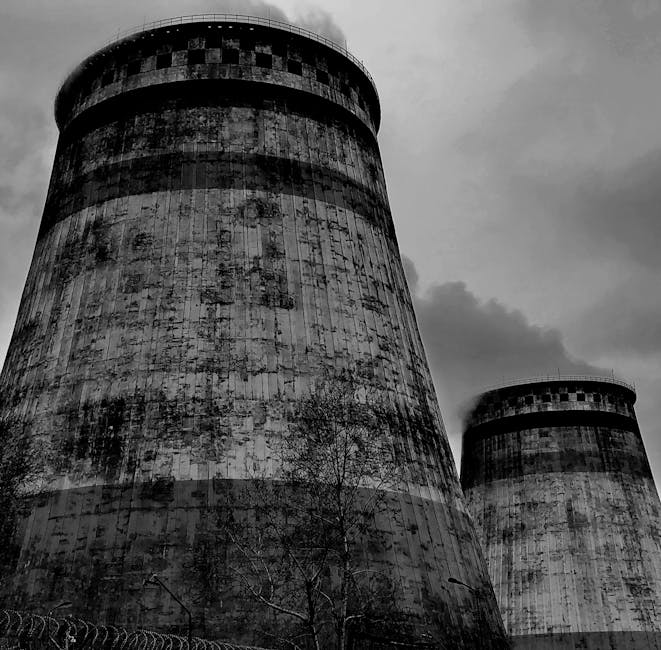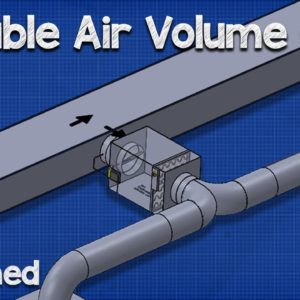Hey there guys, Paul here, from TheEngineeringMindset.com. In this video, we are
going to be looking at the VAV system. VAV stands for variable air volume. VAV systems are very common in offices. This is because they are
much more energy efficient compared to the CAV model, which is a constant air volume. And they also allow
zoning in the building, and that's really handy because not every room in the
building will experience the same heat load. With a VAV system you'll
be able to control the amount of cooling, possibly heating, into each of the rooms individually from the same main duct
work and main AHU system. So as you can see here we've got just a mock up
of a very basic office. So we've got the main
AHU settled over here in the plant room. Then we've got the supply
duct which runs along here, goes through all the rooms in
the mock up of the building. And then on the other side
we've got the return line, which comes back to the AHU, and then it can either be chucked outside if it's dirty air or some
of it can be recycled and used again throughout the AHU.
If you're new to HVAC and
AHU's then I highly recommend you check out some of
our other videos such as "The Fundamentals of
HVAC", "Basics of HVAC". This covers a lot of material in the AHU, what you typically find in each one. So I highly recommend you go back and have a look at these. There's also a link
appearing above you now. Now in a VAV system, the
air coming out of the supply AHU and through the supply duct, the air is running at
about 13 degrees Celsius or 55 degrees Fahrenheit. And that will flow all the way through to the end of this duct here where each of the rooms
can feed off of this and take some of the 13 degree or 55 degree Fahrenheit air as needed. That air distributes into the
room through these diffusers, spreads across and then, as you can see at the back here, there is the return grills
where the dirty used air is picked up and sent back to the AHU.
So the main difference in a VAV system compared to a CAV system is this, the VAV terminal. So this is located just on the branch coming off of the main duct. And each VAV box serves a certain zone. The VAV box is connected
by this cable here to a thermostat which is
located within the room of the zone which needs to be controlled, specifically by the VAV box. The VAV box look something like this, where we've got the inlet
coming off of the duct, the main supply duct. We've got the main VAV box, or terminal, and then we've got the exit, or the supply air,
going off into the zone. If I just make these sides transparent so we can have a look inside, and there we go. Now we can have a look inside the VAV box, or VAV terminal as it should be called. You can see it's a pretty
basic box actually. There's nothing too complex
happening inside these. So we've got the controller located here, mounted on the the actuator. The actuator controls
and rotates the shaft, and connected to the shaft is this damper.
The damper can modulate its position to control and the amount of
air entering into the box, and thus entering into the zone. The air entering the box, like I said, is around 13 degrees celsius
or 55 degrees Fahrenheit typically, but this temperature
can be adjusted via BMS. Sometimes that isn't warm enough so we've got an electrical reheater here which will switch on and it will then just warm that air up as it passes through. You don't necessarily
have to have this inside but it is fairly common.
They don't necessarily
have to be electric either. They could also be fed
from your hot water system or it could also be from a heat
pump or something like that. But for simplicity, I've just left it as electrical reheater. On the backside looking
in through the inlet here, you can see these tubes
which are coming from the controller and off entering into there and connecting to this weird cross shape.
This is an air flow sensor and it is basically measuring the change in pressure across this device. And from that you can
average this and calculate the air velocity, or flow
rate, into the VAV box. Now this works a little like a pitot tube, if you know what that is. But it's not quite the
same in how it works. But I think we'll leave
that for another video. But basically all you
need to know about this is there are some small pinholes
on the front surface here, and also on the back of it. And if you imagine you got
the supply air coming in here and hitting the front of this, then it's gonna impact on
this and cause a pressure, so it's gonna have a high
pressure side on the front here. And obviously the
backside you're gonna get a low pressure point. You can find the differential
pressure across the device, and if you average that
for the size of the duct, and calibrate it a bit, then you can calculate
the flow rate of air entering into that box and zone.
This should show you what some
of the components look like. So this first part here,
we've got the damper. Here you can see the air velocity sensor and also the damper. So this is looking through
towards into the VAV box. Then looking at the
controls point of view, we've got the thermostat,
the air velocity sensor, the controller, and then the actuator. Don't forget the actuator is the device which controls the position
of the damper inside the duct. Now the damper never really closes fully, or at least typically it doesn't. And that's because you still need a certain amount of fresh
air to enter into the space. So air can still get past this and through and into the zones which
the VAV box is controlling. But if you suddenly got a higher heat gain within the room or in the zone, and the temperature in
the room starts to rise above the desired setpoint or the desired temperature of the room, then the damper will start to open, and this will allow
more air into the space.

Remember the air is
about 13 degrees celsius, 55 degrees fahrenheit, so that will start to cool the room down, and force all that hot air
off into the return duct. In the middle of summer
when you've got all those solar heat gains coming
through the windows, and maybe you've got a meeting room and it's full of people,
so there's a lot of heat being generated in there, so the damper will open
to 100% and this will let as much cold air in as possible. And this will then flood into the room, into the zone, and start to
disperse some of that heat. But during the winter
and throughout the normal part of the day when there's
less people in the room, then the damper's position
is further towards the closed position, remember, not fully, and this modulates the cooling.
Now if you imagine these VAV boxes which are connected to the system here, as they can all vary the amount of air which is coming and
filling in to the space, before being returned to the AHU, as they vary that amount of air, then these dampers will start to close. And as they start to close, these fans, here in the AHU, are still pushing out as much
air as possible into this. Now that's gonna really
increase the pressure in these ducts. So what we want to do is
fill a pressure sensor, here towards the furthest
point in the duct, to get the most energy
efficient operation. And these are connected over to the VSD, the variable speed drive, or the variable frequency drive. The VFD is connected directly to the fans, the fan motors, and the VFD will then slow the fans down, slow the induction motors down, and this will reduce the amount of air being pushed into the duct.
The pressure sensor is
set with a set point of where it should be operating at, or what that pressure should be at the end of the duct. And the fans will reduce in speed to reduce the amount of air being pushed into there to match that pressure point. And that means the fans
use way less energy and your main AHU cooling cores will also use less cooling as well.
Obviously the added bonus is that each of the rooms are classed as a zone and they can all be
controlled individually to meet the specific
requirements of that room and the heat gain within it. You can also get some
fan-assisted VAV boxes, which you can see this
box on the side here. There are a lot of variants
you can get on VAV boxes. So this is the most simple
version I could make to show you and help you understand this. I'll just show you inside
the model of that as well. So it is essentially the same, but you can see the panels
have been hidden here. So you've got the filter here
where the air from the space will be coming back into and forcing in through this fan, into this chamber, and that will then mix with
this as the damper opens so the cold air and the warmer
return air from the room will be mixing in here
and that will, and can, pass through the heater
battery if required and off into the zones.
And that's useful because the fan will keep a constant volume
coming through the box so if you imagine as that damper closes the less air volume will be coming through so the fan will ensure that a consistent volume is
coming through that box so you get the air turnover in the room. And it also reduces
the chances of cold air being dumped through out of the diffuser on to anyone sitting below. As that will be very
uncomfortable for them and the staff will become sick, and you'll get sick building syndrome, and lots of calls to the maintenance, etc.
You want to avoid all that so sometimes fans are put
into these little boxes to help the performance. Alright that's it for this video. Thank you very much for watching. Please remember to subscribe,
like, and share the video. And if you have any comments, please leave them in the
comment section below. I'll try to answer these
as soon as possible, or some of the other users
might be able to help you. Don't forget to check out our website, http://www.TheEngineeringMindset.com. And you can also find us on
Facebook, Twitter, Google+. Once again, thanks for watching..

